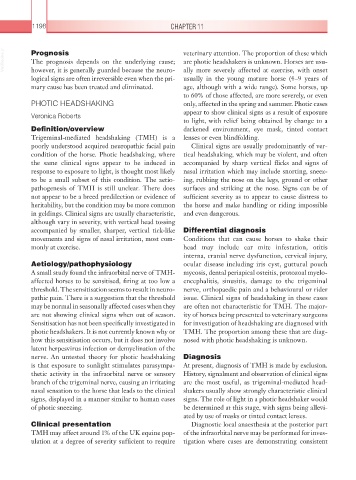Page 1223 - Equine Clinical Medicine, Surgery and Reproduction, 2nd Edition
P. 1223
1198 CHAPTER 11
VetBooks.ir Prognosis veterinary attention. The proportion of these which
are photic headshakers is unknown. Horses are usu-
The prognosis depends on the underlying cause;
however, it is generally guarded because the neuro-
usually in the young mature horse (4–9 years of
logical signs are often irreversible even when the pri- ally more severely affected at exercise, with onset
mary cause has been treated and eliminated. age, although with a wide range). Some horses, up
to 60% of those affected, are more severely, or even
PHOTIC HEADSHAKING only, affected in the spring and summer. Photic cases
appear to show clinical signs as a result of exposure
Veronica Roberts
to light, with relief being obtained by change to a
Definition/overview darkened environment, eye mask, tinted contact
Trigeminal-mediated headshaking (TMH) is a lenses or even blindfolding.
poorly understood acquired neuropathic facial pain Clinical signs are usually predominantly of ver-
condition of the horse. Photic headshaking, where tical headshaking, which may be violent, and often
the same clinical signs appear to be induced in accompanied by sharp vertical flicks and signs of
response to exposure to light, is thought most likely nasal irritation which may include snorting, sneez-
to be a small subset of this condition. The aetio- ing, rubbing the nose on the legs, ground or other
pathogenesis of TMH is still unclear. There does surfaces and striking at the nose. Signs can be of
not appear to be a breed predilection or evidence of sufficient severity as to appear to cause distress to
heritability, but the condition may be more common the horse and make handling or riding impossible
in geldings. Clinical signs are usually characteristic, and even dangerous.
although vary in severity, with vertical head tossing
accompanied by smaller, sharper, vertical tick-like Differential diagnosis
movements and signs of nasal irritation, most com- Conditions that can cause horses to shake their
monly at exercise. head may include ear mite infestation, otitis
interna, cranial nerve dysfunction, cervical injury,
Aetiology/pathophysiology ocular disease including iris cyst, guttural pouch
A small study found the infraorbital nerve of TMH- mycosis, dental periapical osteitis, protozoal myelo-
affected horses to be sensitised, firing at too low a encephalitis, sinusitis, damage to the trigeminal
threshold. The sensitisation seems to result in neuro- nerve, orthopaedic pain and a behavioural or rider
pathic pain. There is a suggestion that the threshold issue. Clinical signs of headshaking in these cases
may be normal in seasonally affected cases when they are often not characteristic for TMH. The major-
are not showing clinical signs when out of season. ity of horses being presented to veterinary surgeons
Sensitisation has not been specifically investigated in for investigation of headshaking are diagnosed with
photic headshakers. It is not currently known why or TMH. The proportion among these that are diag-
how this sensitisation occurs, but it does not involve nosed with photic headshaking is unknown.
latent herpesvirus infection or demyelination of the
nerve. An untested theory for photic headshaking Diagnosis
is that exposure to sunlight stimulates parasympa- At present, diagnosis of TMH is made by exclusion.
thetic activity in the infraorbital nerve or sensory History, signalment and observation of clinical signs
branch of the trigeminal nerve, causing an irritating are the most useful, as trigeminal-mediated head-
nasal sensation to the horse that leads to the clinical shakers usually show strongly characteristic clinical
signs, displayed in a manner similar to human cases signs. The role of light in a photic headshaker would
of photic sneezing. be determined at this stage, with signs being allevi-
ated by use of masks or tinted contact lenses.
Clinical presentation Diagnostic local anaesthesia at the posterior part
TMH may affect around 1% of the UK equine pop- of the infraorbital nerve may be performed for inves-
ulation at a degree of severity sufficient to require tigation where cases are demonstrating consistent

